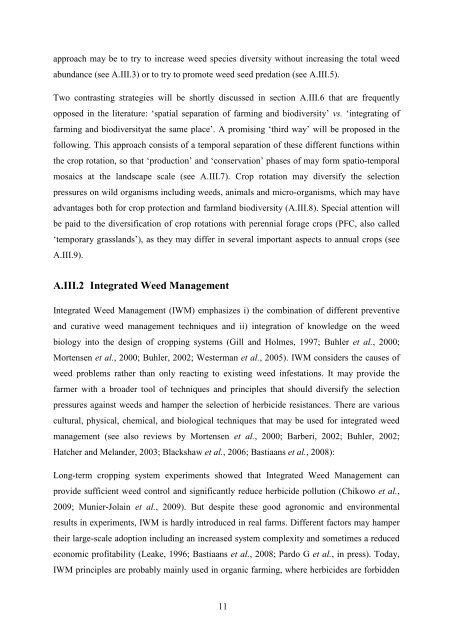Diversifying crop rotations with temporary grasslands - Université de ...
Diversifying crop rotations with temporary grasslands - Université de ...
Diversifying crop rotations with temporary grasslands - Université de ...
You also want an ePaper? Increase the reach of your titles
YUMPU automatically turns print PDFs into web optimized ePapers that Google loves.
approach may be to try to increase weed species diversity <strong>with</strong>out increasing the total weed<br />
abundance (see A.III.3) or to try to promote weed seed predation (see A.III.5).<br />
Two contrasting strategies will be shortly discussed in section A.III.6 that are frequently<br />
opposed in the literature: ‘spatial separation of farming and biodiversity’ vs. ‘integrating of<br />
farming and biodiversityat the same place’. A promising ‘third way’ will be proposed in the<br />
following. This approach consists of a temporal separation of these different functions <strong>with</strong>in<br />
the <strong>crop</strong> rotation, so that ‘production’ and ‘conservation’ phases of may form spatio-temporal<br />
mosaics at the landscape scale (see A.III.7). Crop rotation may diversify the selection<br />
pressures on wild organisms including weeds, animals and micro-organisms, which may have<br />
advantages both for <strong>crop</strong> protection and farmland biodiversity (A.III.8). Special attention will<br />
be paid to the diversification of <strong>crop</strong> <strong>rotations</strong> <strong>with</strong> perennial forage <strong>crop</strong>s (PFC, also called<br />
‘<strong>temporary</strong> <strong>grasslands</strong>’), as they may differ in several important aspects to annual <strong>crop</strong>s (see<br />
A.III.9).<br />
A.III.2 Integrated Weed Management<br />
Integrated Weed Management (IWM) emphasizes i) the combination of different preventive<br />
and curative weed management techniques and ii) integration of knowledge on the weed<br />
biology into the <strong>de</strong>sign of <strong>crop</strong>ping systems (Gill and Holmes, 1997; Buhler et al., 2000;<br />
Mortensen et al., 2000; Buhler, 2002; Westerman et al., 2005). IWM consi<strong>de</strong>rs the causes of<br />
weed problems rather than only reacting to existing weed infestations. It may provi<strong>de</strong> the<br />
farmer <strong>with</strong> a broa<strong>de</strong>r tool of techniques and principles that should diversify the selection<br />
pressures against weeds and hamper the selection of herbici<strong>de</strong> resistances. There are various<br />
cultural, physical, chemical, and biological techniques that may be used for integrated weed<br />
management (see also reviews by Mortensen et al., 2000; Barberi, 2002; Buhler, 2002;<br />
Hatcher and Melan<strong>de</strong>r, 2003; Blackshaw et al., 2006; Bastiaans et al., 2008):<br />
Long-term <strong>crop</strong>ping system experiments showed that Integrated Weed Management can<br />
provi<strong>de</strong> sufficient weed control and significantly reduce herbici<strong>de</strong> pollution (Chikowo et al.,<br />
2009; Munier-Jolain et al., 2009). But <strong>de</strong>spite these good agronomic and environmental<br />
results in experiments, IWM is hardly introduced in real farms. Different factors may hamper<br />
their large-scale adoption including an increased system complexity and sometimes a reduced<br />
economic profitability (Leake, 1996; Bastiaans et al., 2008; Pardo G et al., in press). Today,<br />
IWM principles are probably mainly used in organic farming, where herbici<strong>de</strong>s are forbid<strong>de</strong>n<br />
11

















